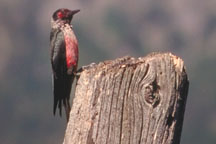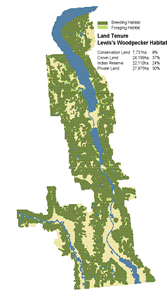|
Habitat Atlas for Wildlife at Risk
Lewis's Woodpecker
Melanerpes lewis

Lewis's
Woodpecker
|

- Length: 22 cm; Wingspan: 45 cm.
- Greenish-black back, pink belly, grey collar and
red face.
Status:
British Columbia Blue List
Special Significance
Loss of large nesting and roosting trees in ponderosa
pine forests and cottonwood bottomlands, seems to
be the main threat to the population of Lewis's Woodpeckers
in British Columbia. An increased awareness of the
importance of maintaining brush and undergrowth to
support insect populations is required. This undergrowth
also provides berries and seeds which are a vital
source of food for this woodpecker. The continued
survival of this woodpecker would be assisted by
protecting their important habitats, particularly
nest sites.
Distribution
- Lewis's Woodpeckers are locally distributed in drier parts of
the Southern Interior of British Columbia from the Chilcotin River
to
the East Kootenays; centre of abundance is the
Okanagan Valley.
- Formerly found on the south coast of British Columbia
when large, low elevation clearcuts provided suitable
habitat, but abandoned that part of the range as new forests grew
up and urban
expansion replaced other open woodlands.
- Primarily a migratory species, but a few individuals
stay in Okanagan Valley in winter
- Ranges up to 1150 metres elevation; breeds from up
to 950 metres.
Habitat
- Open ponderosa pine forests and old cottonwood stands in riparian
areas are the Lewis's Woodpecker's major breeding
habitat, although they also nest in burned-over stands of Douglas-fir,
mixed conifer,
deciduous woodlands, grassland with scattered decaying
trees, and suburban areas with large trees.
- Nest in tree cavities excavating new nest cavities,
but will often use abandoned holes and natural
openings in living and dead trees. Ponderosa pine and black cottonwood
are preferred
nest trees.
Reproduction
- Lewis's Woodpecker pair bond may be life-long.
- Lay 4 to 6 eggs in May or June; eggs hatch about 2
weeks later.
- Eggs incubated by both parents except at night, when
male sits on eggs while female sleeps in another
cavity.
- Young leave the nest 4 to 5 weeks after hatching.
Food Habits
- Summer diet is mainly flying insects caught during long, circling
flights.
- Fruits, berries and nuts (especially acorns) are
important foods in late summer, fall and winter.
- Overwintering birds store nuts in cracks in dead
snags and power poles.
Ineresting Facts
- This species' habit of catching insects during long flights, much
as swallows and nighthawks do, is very unusual in the
woodpecker family.
- Named after Meriwether Lewis of the Lewis and Clark
expedition.
Threats
- Felling of large, standing decaying trees (snags);
these are potential nesting and perching
sites.
- Loss of habitat, especially open ponderosa pine
woodlands and riparian forests.
- Netting around vineyards could be a serious source
of mortality in late summer.
- Use of insecticides in orchards and gardens may
reduce insect population.
- Competition with European Starlings for nest sites
may be a problem, but this species seems
to stand up to the aggressive starlings more than most other
birds.
Management Considerations
- Preserve and maintain ponderosa pine forests
and black cottonwood stands.
- Protect known nest sites.
- Maintain dead or dying standing trees, especially
soft, large diameter snags.
- Monitor and reduce the use of pesticides.
|
References
1. Campbell, R.W., N. K. Dawe, I. McTaggart-Cowan, J. Cooper, G.
Kaiser and M.C. McNall. 1990. Birds of British Columbia: Volume 2.
Royal British Columbia Museum,Victoria, BC.
2. Ehrlich, P.R., D.S. Dobkin, and D. Wheye. 1988.
The birder's handbook: a field guide to the natural history of North
American birds. Simon and Schuster, New York.
3. Cannings, R.A., R.J. Cannings and S.G. Cannings.
1987. Birds of the Okanagan Valley, British Columbia. Royal British
Columbia Museum, Victoria, B.C.
|